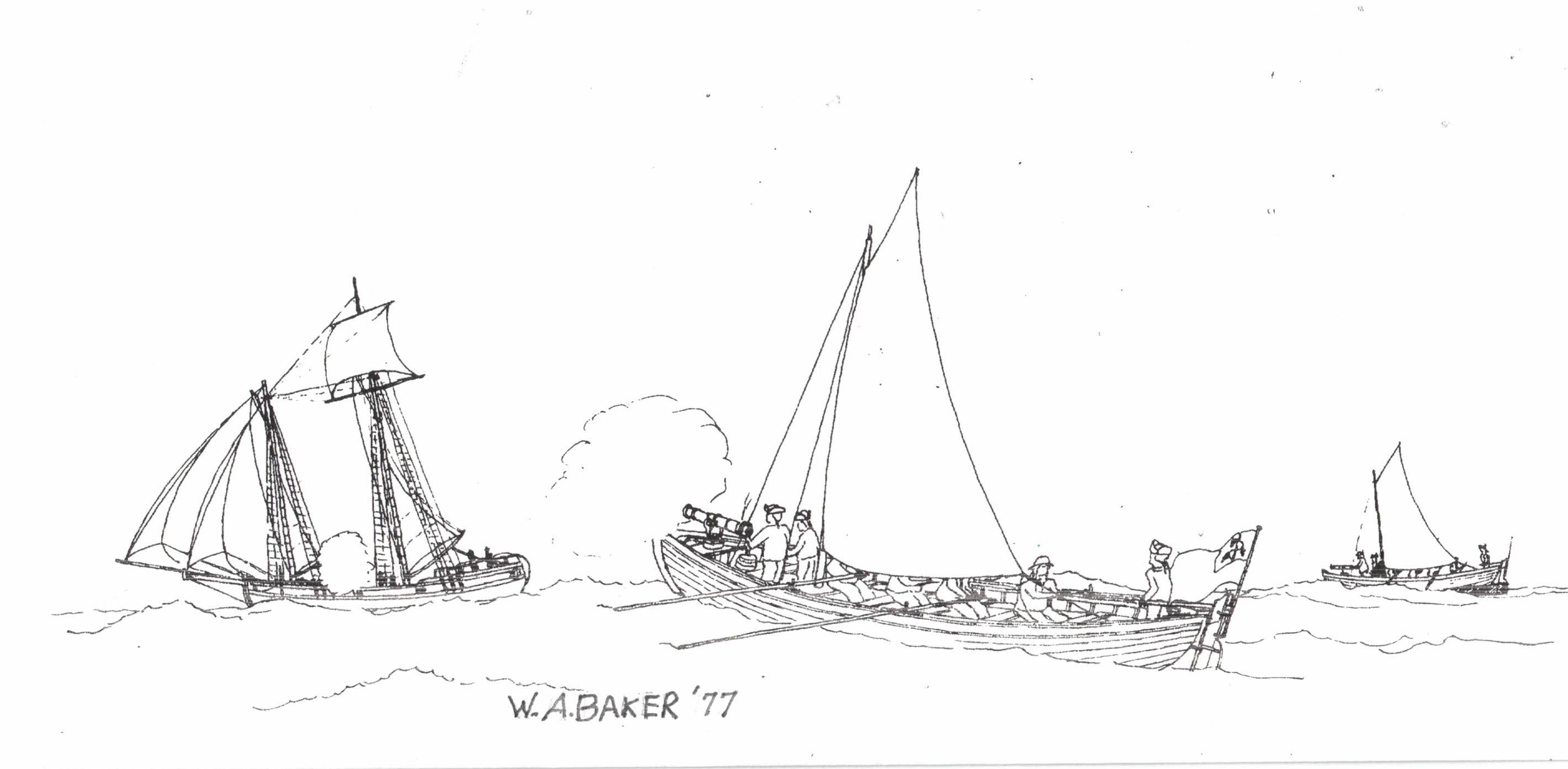CONNECTICUT'S REVOLUTIONARY WHALEBOAT WARFARE
– New Data Access
Thanks to Mystic Seaport’s Research Center and the efforts of historian, Patricia Q. Wall, a wealth of data on a lesser-known chapter of America’s fight for Independence is now available on-line under “Records of the Connecticut Maritime Court 1777 – 1783.” The site presents Mrs. Wall’s abstracts of cases for Fairfield County’s court as well as her new research on an extensive list of Rebel whaleboat captains. With her permission, the following are some excerpts from her essay appearing on the Seaport’s website.
The Editor.

“One of the richest sources of Connecticut history during the American Revolution is its maritime court records. Generated in four county courts – Fairfield, New Haven, Hartford, and New London - they are full of drama and human striving as hundreds of captains and thousands of crewmen went after and captured British and Tory ships, vessels, and supplies on the high seas and on Long Island Sound. As required, they then sought remuneration by having their captures deemed lawful by court decree before the vessels and supplies were publicly auctioned. A portion of proceeds also went to the State or County treasury. Aside from many exciting revelations on circumstances of such captures, it is sometimes the court depositions of other claimants which make for intriguing insight on human attitudes and behavior in wartime.
|
“Most, if not all, of those records survived to be deposited in the Connecticut State Library and it appears that, other than Lewis F. Middlebrook’s exploration of them in preparation for his outstanding two-volume work, Maritime Connecticut During the American Revolution (Salem, MA. Essex Institute, 1935), they have received little published attention from other scholars. Over time, the documents’ fragile, deteriorating condition has rendered them closed to general research. However, in the early 1970s, at the request of several historians searching for new material for the US Bicentennial celebrations (myself, Ronald Marcus of Stamford, and Lois Bayles of New Canaan), the State Archivist, the late Robert Claus, agreed to have the collection prepared for copying. Each case packet was opened, its contents unfolded and then given curatorial treatment. Intriguingly, in the process of the unfolding, it appeared quite a number of the documents had never been opened as evidenced by the falling out of ink-drying caster sand often used by 18th century scribes.
“Using only the xerox copies, I created an index for each county’s records to enable more access to that trove of data, especially on individuals. There are close to 5000 men and a few women cited. In addition to the indexing, I had planned to make abstracts of all the court cases but was unable to complete more than those for Fairfield County before life’s circumstances interfered. At least the indexes are now available from the State Library’s online database and hopefully someday the rest of the counties’ case abstracts will be completed.
WHALEBOATS TO THE FORE
“Since Fairfield County Maritime Court cases are almost entirely concerned with captures by captains and their oarsmen in doubled-ended, open-to-the-weather whaleboats, it seems appropriate to provide here not only abstracts of all that court’s records, but also include what I have found concerning whaleboat captains in action along the Connecticut coast generally. There are 175 names from various sources, but no doubt numerous others are yet to be discovered. While most men on the list have considerable documentation, some have little more than say-so. However, the term ‘captain’ has been applied to all on the list – commissioned and otherwise authorized commanders of the boats and the ‘say-sos’. Often, a given captain had two or more boats under his command and occasionally his lieutenant or ensign in one of the boats lead or was given authority in a capture.
As to the designation of ‘whaleboat’, a careful reading of court cases show the term also applied to boats cited as ‘armed boats’ and even sometimes to a boat initially description as a sloop. The latter is understandable since whaleboats were commonly outfitted with a removal mast, a spritsail or other rig to make way for battle or drawing ashore. For some of the boats’ wartime history, readers are referred to Whaleboat Warfare On the Sound by John Gardiner in The Log of Mystic Seaport, Vol. 28, No. 2, (July 1976). For further history, and design of such boats, see The Whaleboat “Middlesex” Technical Notes by eminent naval architect, William Avery Baker, in Nautical Research Journal, Vol. 29, No. 3 (September 1983). The Middlesex, by the way, is a full-size replica of the type of 18th century boat used during the Revolution and was built from William Baker’s original design under the auspices of the Darien Historical Society in honor of the U.S. 1775 Bicentennial. Though I suggested the idea and acted as coordinator, that amazing educational project only came about as a result of a dedicated core of volunteers, fund raises, and patient, believing committee members.”
For details of that Bicentennial accomplishment, See "Whaleboatmen" from CT Old House Journal Issue #27, Winter 2020. The Middlesex went on to serve as a water-born source of history education for more than a decade, even sometimes adapted for handicap rowers, until necessity brought her ashore permanently. Restored for display only in 2022, the Middlesex continues serving education at Darien’s Museum Center. Regrettably, her Bicentennial counterpart, the Henry Scudder has gone the way of all things. Continuing with Mrs. Wall’s essay from Mystic’s website, she offers a challenge to scholars. The Editor.
“I believe another important reason for bringing this collection of Revolutionary maritime data online is to encourage professional historians and history students at the graduate level to take a fresh and objective look at the subject of whaleboats in the American Revolution in all the various theatres of action from Maine on down the Atlantic coast to the Delaware River. Their employment during the war involved untold thousands of oarsmen – at first, intrepid New England fishermen, local militia, and then Continentals re the blockading British fleet in spring 1775. It was armed whaleboats that was on Washington’s mind in June 1775 as he commenced taking command of the new Continental Army in Boston - a flotilla of 100 of those boats, some equipped with swivel guns and grappling hooks, and manned by 601 men plus a contingent of officers. Their daring, spunky service for about the next five or so months offer some of the most exciting, gratifying stories of the early Revolutionary fight. (2)
“Then, come April 1776, before Congressional efforts to form a navy, the members established rules for privateering. And of course, that ruling would drive a great deal of the story of whaleboat employment and action from then on. When given a careful search, it is intriguing to discover how continuous is the strong thread of that story – oarsmen’s fighting and enterprising – throughout the years of the Revolution. For the Connecticut-Long Island struggle, General Washington would eventually name it “The Petite Guerre” – a fight which he seemed to view with mixed feeling. (3)
“Even before the Lexington and Concord encounters, the stage was being set for future hostility between Connecticut and neighboring Long Island as Liberty-determined Rebels acted to quelch Tory (British loyalist) opposition, eventually causing a thousand or more of them and their families to seek refuge on the Island - primarily in the loyalist stronghold of the Huntington-Oyster Bay region. And, after Washington’s army lost the Battle for Long Island in fall 1776, the British swept down that extensive Island causing a thousand or more Rebels to flee to Connecticut.
“Inevitably, that key wartime factor began taking hold – supply. For the refugees, both groups were generally destitute, having left most everything behind. Their needs, especially those of the loyalists, would prove a source of increasing conflict and disasters as the war progressed. As for the British forces, they set about making Long Island their breadbasket and woodshed - a major source of provisions, of fodder for their horses, and most especially, firewood from the Island’s vast forests to provide not only warmth, but a steady supply of fuel for camp and hearth cookers and ship’s galley stoves. By early 1777, a main depo for supplies and shipping to New York would be centered at Huntington and Oyster Bay.
“Of course, Rebels – military and self-motivated - would do everything in their power to keep preventing or disrupting that supply and its shipping. And, as things turned out it was determined captains and brawny oarsmen in humble double-ender whaleboats that waged most of that effort in Connecticut waters and likely a considerable amount of that in the waters of New Jersey, the Hudson and elsewhere. True, the literature abounds with articles on whaleboat warfare, but nearly all of is limited to selected heroes and scattered incidents. A fresh, more comprehensive study of the historical records soon reveals ever so more to the saga of oarsmen’s role in the Revolution than what has come into print. When the late naval historian, David Syrett, wrote that there were “thousands of whaleboat raids carried out by the Americans” and that “ships of the Royal Navy appeared almost helpless when confronted with one of the most effective American weapon systems – whaleboats” - it appears well-past time to cast brighter light on the saga and role of the Revolution’s fighting oarsmen.” (4)
1. Flag illustration – Vol. 2:16, Louis F. Middlebrook, Maritime Connecticut during the American Revolution. (Essex Institute. Salem, MA, 1935)
2. Joshua Davis to General Washington, 22 July 1775. The George Washington Papers, LC. See Founders Online.
3. Vol. 23:21, John C. Fitzpatrick. Writings of George Washington 1745 to 1799. 37 vol. (Washington, DC. US Government Printing Office, 1931-1944.)
4. Pages 14, 15, David Syrett. “Defeat at Sea: The Impact of American Naval Operations Upon the British, 1775-178.” Maritime Dimensions of the American Revolution. Naval History Division, Department of the Navy. Washington, DC. 1977.
Patricia Q. Wall, a resident of Exeter, NH, is the author of Lives of Consequence: Blacks in Early Kittery & Berwick in the Massachusetts Province of Maine (2017) and two children’s books on New England’s black history, Child Out of Place (2004) and Beyond Freedom (2010). |

 Structural Products & Services, Stairlifts
Structural Products & Services, Stairlifts





